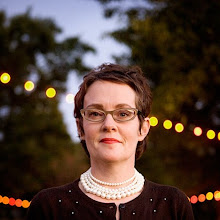 Jackson Square, New Orleans. All photos courtesy the author.
Jackson Square, New Orleans. All photos courtesy the author.I just logged my fourth trip in two years to New Orleans to continue work on a series of projects linking St. Louis to New Orleans.
 Freedom Ride. Image by Joe Baker.
Freedom Ride. Image by Joe Baker.I timed my visit to see the first three acts (the work awaits more funding to be completed) of
Freedom Ride, an opera by Xavier University professor Dan Shore commissioned by friend and Longue Vue House and Gardens Director / Chief Curator Joe Baker. The Freedom Riders drove from Washington to New Orleans to defy the segregation of interstate transportation. Edith and Edgar Stern, founders of Longue Vue, hosted the group when they arrived in the South. Edith founded the opera program at Xavier, another elegant connection in this program.
The opera was magical, the powerful voices of the singers evoking the hope and anger of people soul-tired of waiting for their civil rights.
It is hard not to layer issues of race and class when visiting the South, particularly in this economic climate and post-Katrina. While not every artist needs to explore these issues, it's hard not to look for kernels of connection when viewing
Prospect.2, which also opened the same weekend as the opera debut. Through reviews of friends who attended Prospect.1, and through the press I read, it sounded as if the first iteration had much more funding. Lack of funding, however, doesn't explain the problems I observed in Prospect.2.

Dan Tague, Crisis Car CC829, 2011.Sadly, the worst of the installations were in two of the biggest institutions in town. At the Contemporary Art Center, where Prospect founder Dan Cameron used to work, was work by Dan Tague alongside some compelling works by local and international artists, but the whole experience felt disorganized and disgruntled.
I have not be impressed by the shows I've seen at the CAC--is it lack of will, lack of standards, lack of expertise? I am sure there was a lot of local anger at how diverse and global Prospect.1 was--does Prospect.2 suffer because Cameron was obliged to capitulate to local demands and sensibilities?
 Jennifer Steinkamp at the New Orleans Art Museum.
Jennifer Steinkamp at the New Orleans Art Museum.Jennifer Steinkamp's haunting, moving trees in a niche at the top of the lobby stairs at NOMA was glorious--too bad the whole thing was washed out by the light of the lobby. The other works that hung on the lobby's walls felt like an after-thought, a concession NOMA made to Prospect.2 without truly giving over any real gallery space. Why wasn't the Odili Donald Odita mural that was going up by the cafe included in Prospect.2? It felt as if NOMA gave over its least art-appropriate space, and grudgingly at that, in order to be listed on the Prospect.2 letterhead.
 Sophie Calle in the 1850 House in the Vieux Carre.
Sophie Calle in the 1850 House in the Vieux Carre.Works placed inside other types of institutions seemed to fare much better by being given a context within which to live. Sophie Calle's multi-room installation in the 1850 House put her self-involved stories into an historical space. But Calle's modern narcissism seemed rather trite alongside the issues of slavery, immigration and disease that are animated through the stories of the people who lived at the 1850 house.
 Ragnar Kjartansson, The Man, 2010Ragnar Kjartansson
Ragnar Kjartansson, The Man, 2010Ragnar Kjartansson's video
The Man was not commissioned by Prospect but was a 2010 collaboration between the artist and musician Pinetop Perkins, the last of the Delta Blues musicians. Was this location chosen as a subtle comment on the role of African Americans in driving the economy of the South, with the blues being subversive resistance of the economic exploitation suffered by African Americans? Subtle thinking indeed, but at least the work was lovely and haunting.
 Nick Cave at the Newcomb Art Gallery, Tulane University.
Nick Cave at the Newcomb Art Gallery, Tulane University.Nick Cave and Joyce Scott were paired at the Newcomb Art Gallery, and although I am not interested in Scott's work and Cave's work speaks to me, there were enough interesting ways to think about the two that the pairing was not disheartening in the way some of the other group shows were.
 Joyce Scott at the Newcomb Art Gallery, Tulane University.
Joyce Scott at the Newcomb Art Gallery, Tulane University.Finally, one great public art piece I saw was Michel De Brion's work
Majestic, curated and produced by
The Third of May Arts, Inc., a Canadian producing collaboration.
 Michel De Brion, Majestic, 2011.
Michel De Brion, Majestic, 2011.De Brion used old New Orleans city lights to make this work parked under the shadow of the freeway overpass in the tangle of streets bisected by the badly designed freeways. Like a pick-up-jack, I thought about the dislocation and re-ordering of the landscape of New Orleans because of Katrina, and the ways in which the city continues to try to put itself back together again. This work was a lovely surprise, stuck, as it was, in this no-man's land.
What a tough balance Prospect.2 had to navigate--how to concentrate installations / art works so that more people can see them while allowing the type of commentary of engaged public art that gives relevance to a biennial in a place as complex and contested as New Orleans? Prospect.2 seems to have galvanized more local activity. I picked up the first issue of
Catalogue, which listed the various galleries and public art works happening around town. Surely that alone is a good thing, giving voice to the non-institutional voices.
I am eager to see what the next version of Prospect will be if simply to see how new genre public art can re-invent itself at each iteration.
























































